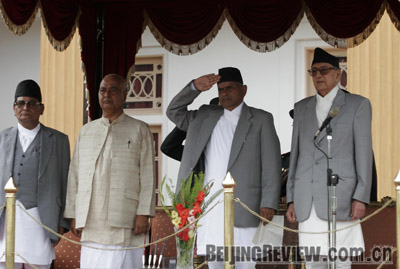|
|

|
|
PONDERING THE FUTURE: Ram Baran Yadav (second from right), the first President of the Republic of Nepal, is sworn in on July 23 in Kathmandu |
More than three months after it became a republic, Nepal will hopefully have a new government soon, with the election for prime minister slated for August 15. The Constituent Assembly declared Nepal to be a “federal democratic republic” at its first meeting on May 28, ending the nearly 240-year-old Shah Dynasty as well as Nepal’s monarchy, which had ruled the Himalayan country on and off for more than 2,000 years.
The new republic announced a three-day holiday, during which the Communist Party of Nepal (Maoist) and other political parties staged celebrations. Most Nepalese people, however, spent the holiday at home with complex sentiments without feeling the joy of a “new birth.” Nepal began a new chapter in its history amid looming uncertainties.
What led Nepal’s monarchy to its demise? What changes have taken place in the country? Why has it been plunged into a political deadlock? A review of the historic events in Nepal in the past three years provides a partial answer to these questions.
The fall of a dynasty
King Gyanendra dismissed the four-party coalition government and personally assumed state power on February 1, 2005. Nepalese kings have seized direct rule and expanded the powers of the royal family several times in Nepal’s history. King Gyanendra wanted to follow suit.
Fed up with the corruption of government officials and the endless wrangling of political parties, the Nepalese gave their king a chance, as politicians and scholars debated the constitutionality of the move. But the king did not come up with any new initiatives. Instead, he marginalized the parties, ordered intensified military attacks against Maoist guerillas and failed to introduce major economic reforms.
One year later, Nepal’s economy and security showed no signs of improvement, leaving the Nepalese extremely disappointed. The cornered parties and Maoist guerillas formed an alliance in New Delhi to jointly lead a “people’s movement” against King Gyanendra’s rule. In April 2006, the king was forced to reinstate the parliament, bringing an end to his brief rule. The monarchy was deposed in May, as King Gyanendra was deprived of all his privileges.
King Gyanendra was responsible for Nepal’s drastic social fluctuations. His unrealistic move to seize state power made it possible for the country’s two major political forces-the parties and Maoist guerillas-to become allies to dethrone the monarchy.
The monarchy was doomed when the Constituent Assembly opened discussions on Nepal’s future political system. Not only did the Maoists stand firmly for abolishing the monarchy, the other parties also hoped to eliminate any chance for the king to restore monarchic rule. Some Nepalese observers believe that if a referendum were held, most Nepalese would choose to keep a ceremonial monarch as a symbol of national coherence and unity.
Seeing their country’s longstanding monarchy consigned to history, the Nepalese are filled with mixed feelings. The monarchy, with its many eminent kings, contributed to Nepal’s national unity. Now that it has been scrapped, expectations for change are high among the Nepalese. They expect the republic to deliver real benefits. If it fails to do so, memories of the old monarchic days, which were certainly not good but still tolerable, could lead to calls for their return.
The rise of Maoists
The seven-party coalition and the Maoists established an interim government in April 2007. Its mission was to organize the election of the Constituent Assembly, which will draft a new constitution to determine Nepal’s future political system. The Constituent Assembly will also function as the interim parliament until the new constitution is adopted and a regular government installed.
| 